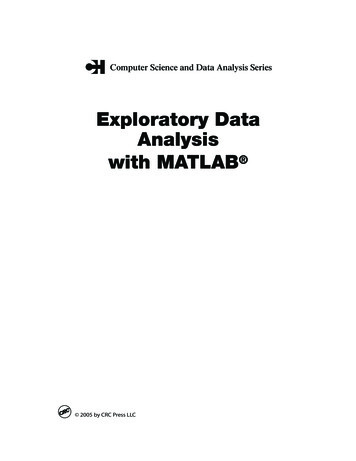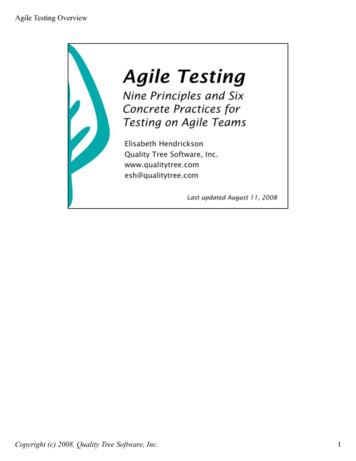
Transcription
Exploratory Testing in anAgile ContextElisabeth HendricksonQuality Tree Soft ware, Inc.www.qualitytree.comesh@qualitytree.comTo contact me after this session,text WSA to INTRO (46876)Copyright 2011 Quality Tree Software, Inc.
2Chapter 1: Explorations“Exploratory Testing” is a style of testing in which we learn aboutthe behavior of a system by designing a small test, executing itimmediately, using the information gleaned from the last test toinform the next. We continuethat rapid cycle of design atest, execute it, observe untilwe've characterized thecapabilities and limitations ofthe system with respect to acharter, or mission.Let's examine each of thesethree key aspects in moredetail.Exploratory Testing is:Simultaneously learningabout the systemwhile designing andexecuting tests, usingfeedback from the lasttest to inform thenext.Copyright 2011 Quality Tree Software, Inc.
31. Designing.Good testers know a lot about test design. Test design involvesidentifying interesting things to vary, and interesting ways in whichto vary them. We can design tests around data: boundaries, specialcharacters, long inputs, nulls, number fields with 0, etc. We can alsodesign tests around sequences and logic using state models,sequence diagrams, flow charts, decision tables, and other designartifacts. All the traditional test design techniques apply. Thedifference is that while we might make notes about the tests we'redesigning, we aren't writing down formal test cases.2. Executing.As soon as we think of a test, we execute it. This is whatdistinguishes exploratory testing from other styles of testing. We’renot squirreling away a large set of designed tests for some futureCopyright 2011 Quality Tree Software, Inc.
4time when we (or someone else) will execute them. We executethem immediately.3. Observing / Learning.We’re observing what the system does and does not do. We discoverhow it operates. We find its quirks and peculiarities whilecharacterizing its capabilities and limitations. Further, we’re learningthe system well enough that we can reflect our observations back tothe rest of the team. The information that our explorations uncoverwill help to move the project forward, but only if we can report it outChecked Explored Testedin a way that the rest of the team can digest.Two Sides of Testing: Checking and ExploringThere is a perpetual ongoing debate in the testing community: Does"good testing" emphasize executing a comprehensive set of scriptedtests designed from the requirements of the system? Or should weCopyright 2011 Quality Tree Software, Inc.
5instead take an exploratory approach to discovering the real risks inthe system?The answers to these questions have historically divided the testingcommunity and the debate has sometimes become downrightrancorous with each side accusing the other of irresponsiblepractices that increase risk and decrease quality.However, the debate represents a false dichotomy. Agile teams donot do one or the other; they do both.Agile practices like TDD and ATDD result in automated regressioncode-facing and business-facing checks. We run these checks as partof the CI build so that they tell us any time a change results in apreviously met expectation being violated.For example, if we are working on a story around editing profiles,we might have an acceptance test like this Cucumber scenario:Copyright 2011 Quality Tree Software, Inc.
6Given I am not logged inWhen I visit the Edit Profile pageThen I should be redirected to the Login pageWhen I log inThen I should be redirected to the Edit Profile pageIf we ever made a change that inadvertently caused any aspect ofthis behavior to change, we would want to know. Even if we hadn'tautomated this test, it is a check that we would want to run all thetime.However, there can be any number of unintended consequences thatacceptance tests would not expose. This acceptance test will ensurethat a user has to be logged in to edit their profile. But what if userswho are logged in can edit any other user's profile as well? Theseare the kinds of risks and vulnerabilities that exploratory testing canreveal.Copyright 2011 Quality Tree Software, Inc.
7Because an agile development can accept new and unanticipatedfunctionality so fast, it is impossible to reason out theconsequences of every decision ahead of time.In other words, agile programs are more subject to unintendedconsequences of choices simply because choices happen somuch faster. This is where exploratory testing saves the day.Because the program always runs, it is always ready to beexplored.[T]here is a tremendous opportunity in front of us if we are justwilling to support exploratory testing with the same vigor thatwe now support automatic testing.--Ward CunninghamPosted March 25, 2004 by on the agile-testing mail list(see e/3881)Copyright 2011 Quality Tree Software, Inc.
8Tests as ExperimentsWhen we design tests while exploring, we have a hypothesis abouthow the software will behave: perhaps we suspect the software willexhibit a particular type of error, or perhaps we are seeking toconfirm how the software works.Either way, we think of a little experiment, and then perform itimmediately. Our experiments teach us about the system. We learnhow it works, what makes it tick, how it’s organized. We discovernot just what works and what doesn’t, but also general patterns ofvulnerabilities.The more we learn about how the system works, and thecircumstances under which it misbehaves, the better we are atdesigning good experiments that yield useful information.Copyright 2011 Quality Tree Software, Inc.
9Note that each of our experiments involves a hypothesis: aprediction about the resulting behavior of the system. We mightstart with a hypothesis that the system will be able to handle whatwe are throwing at it. Or we might start with a theory of error: aguess about the risks we’re about to uncover. Either way, eachexperiment is deliberately designed to conform our refute ourhypothesis.The idea that exploratory testing is a deliberate and thoughtfulprocess surprises some.Really? No Keyboard Banging?Sometimes we do things when exploring that seem odd to anoutside observer. For example James Bach talks about his “ShoeTest” in which he places a shoe on the keyboard.Copyright 2011 Quality Tree Software, Inc.
10TestingTool?But James doesn’t put a shoe on the keyboard because he’s trying tocome up with wacky random stuff. He does it because he hasnoticed that some software exhibits bad behavior when it receivestoo many key inputs at one time. Placing a cat on the keyboard, orhanding the keyboard to a 2-year-old, might result in similarbehavior. But a shoe or a book is usually more handy.So yes, there might be keyboard banging involved in ExploratoryTesting. But it’s keyboard banging with a theory of potential error,not just random wacky stuff because we can’t think of anythingbetter to do.Copyright 2011 Quality Tree Software, Inc.
11UnbreakableI first visited Atomic Object in Grand Rapids, Michigan a few years ago.After initial introductions, Karlin Fox took me over to a workstation andintroduced me to a system that they had recently put into production.The system was a kiosk to be installed in home improvement stores thatwould allow users to see a preview of a new paint color in rooms in theirhomes. Users could upload a picture of a room from external media suchas a CD or USB drive, then manipulate the picture, changing the color ofthe walls.Karlin suggested that I explore.I started by acting as a consumer. I experimented with uploading variouspictures and painting the walls. I quickly realized that I would not findanything surprising on the happy paths.Next I channelled my inner 3 year old and tried interrupting the system bypulling out the media and hitting keys randomly. For every scenario Itried, the system responded in a reasonable way.Copyright 2011 Quality Tree Software, Inc.
12Undaunted, I tried corrupting data, providing invalid file formats, andpotentially risky file names.I have explored numerous systems produced by high caliber teams overthe years. Usually I find any number of bugs, often serious ones. Much tomy surprise and delight, I could not find anything that I considered adefect in this kiosk application.Curious as to how the team had created software that I could not break, Iasked about the process the team used. Karlin told me that they had anexploratory tester on the team."He drove us nuts!" he reported. "Always finding stuff." Karlin paused.Then his face lit up. "It was great!"Copyright 2011 Quality Tree Software, Inc.
13Chapter 2: OrganizedExplorations: Chartersand SessionsIn a letter dated June 20, 1803, Thomas Jefferson, the 3rd Presidentof the United States, gave the explorers Lewis and Clark a mission:The Object of your mission is to explore the Missouri river & suchprincipal stream of it as by its course and communication withthe waters of the Pacific ocean, whether the Columbia, Oregon,Colorado or any other river may offer the most direct &practicable water communication across this continent for thepurpose of commerce.Copyright 2011 Quality Tree Software, Inc.
14The content of the objective that Jefferson set forth is significant.Notice that Jefferson specified the areas he wanted explored: theMissouri river and connecting waterways to the Pacific. Notice alsothat he specified "for the purpose of commerce." He was interestedin a passageway for commerce; he was not particularly interested innice picnic spots or locations for future national parks.Earlier in that same letter letter, Jefferson told Lewis and Clark whatthey would have to work with:Instruments for ascertaining, by celestial observations, thegeography of the country through which you will pass, havealready been provided. Light articles for barter and presentsamong the Indians, arms for your attendants, say from ten totwelve men, boats, tents, and other traveling apparatus, withammunition, medicine, surgical instruments and provisions, youwill have prepared, with such aids as the secretary at war canCopyright 2011 Quality Tree Software, Inc.
15yield in his department; and from him also you will receiveauthority to engage among our troops, by voluntary agreement,the attendants above mentioned; over whom you, as theircommanding officer, are invested with all the powers the lawsgive in such a case.Exploring software has much in common with exploring territory: There are any number of surprises and adventures awaiting us(including bugs). We can use tools to help us; however, the most important tool wecarry is the one between our ears. Sometimes exploring is a fun romp, sometimes it's a slow slog,and sometimes we tread on treacherous ground. Finally, if the map and the territory differ, believe the territory.Copyright 2011 Quality Tree Software, Inc.
16Thus it should come as no surprise that the contents of the charterthat Jefferson gave Lewis and Clark can serve as a model for thecharters we'll create for exploratory testing.Jefferson specified where to explore, the resources the explorerswould have to work with, and the information that they were toseek:Explore areawith resourcesto discover informationIn the case of Lewis and Clark, they were to:Copyright 2011 Quality Tree Software, Inc.
17Explore the Missouri river & suchprincipal stream With instruments for ascertaining, bycelestial observations, the geographyof the country To discover direct & practicable watercommunication across this continent.In testing software, we have different objectives. We will beexploring some externally visible behavior such as a feature in asystem. We might explore using tools or resources such as aspecific data set. However, like Lewis and Clark, our ultimate goal inexploring is to discover information that will help move the projectforward.Copyright 2011 Quality Tree Software, Inc.
18Our charters look like:Explore a story, feature, area, or systemwith resources, constraints, heuristics,or other featuresto discover informationFor example, imagine we have a story like:As a user, I want to update my personalinformation on my profile so that mypublic profile stays up to date.And we might have charters like:Copyright 2011 Quality Tree Software, Inc.
19Explore editing profileswith sql and javascript injection attacksto discover security vulnerabilitiesExplore editing profileswith the authentication featureto discover surprisesExplore editing profileswith different kinds of usersto discover interactions between profileediting and rolesCopyright 2011 Quality Tree Software, Inc.
20Good ChartersA good charter offers direction without over-specifying test actions.Too SpecificAs an example, the following isn't a charter; it's a test case.Explore editing last namewith the value "O'Malley"to discover if the profileedit feature can handlenames with apostrophesWhen charters are too specific, they become just a different way ofexpressing individual tests. If they are tests that we need to repeatwith every iteration, they should be automated.Copyright 2011 Quality Tree Software, Inc.
21By contrast, charters that are too broad run the risk of not providingthe most important information. Like a story that is too big andambiguous, we don't know how to tell when we're done.For example, the following charter calls for exploring the entiresystem with a large and undefined set of resources. The result is sovague that we could spend weeks investigating it and still not beToo Generalsure we discovered all the important risks and vulnerabilities.Explore system securitywith all the hackingprograms we can findto discover any securityholesCopyright 2011 Quality Tree Software, Inc.
22It is better to focus on a single area and/or specific types of securityholes with each charter. A better set of focused security-relatedcharters might be:Explore input fieldswith javascript and sql injection attacksto discover security vulnerabilitiesExplore pages requiring loginwith spoofed URLs and POST parametersto discover if users can gain access tocontent they did not pay forCopyright 2011 Quality Tree Software, Inc.
23About The Charter TemplateThe formulaic "Explore/With/To Discover" is like the user storyformat of "As A / I want / Because." It reminds us of the informationthat we need.However, sometimes the phrasing is awkward. It can feelconstraining rather than supporting if the ideas we want to expressdo not fit neatly into the structure. We want to say:"Play with buffer overflow exploits to try to gain shellaccess to the server"If we constrain ourselves to fit every charter into the “explore/with/to discover” format we end up with the much more awkward:Explore inputswith buffer overflow exploitsCopyright 2011 Quality Tree Software, Inc.
24to discover if there is any way a user couldgain shell access to the serverAs with any template, this format for phrasing charters is just aguide. It appears throughout this document, but please do notinterpret that as a “one right way” to express charters. Theimportant thing about charters is that they focus our efforts withoutconstraining our thinking.Copyright 2011 Quality Tree Software, Inc.
25Chapter 3: "Recon"In their “ET with Subtitles” video, James and Jon Bach perform whatthey call a “Recon” session on an “Easy Button,“ a novelty toy with asingle button that, when pressed, prompts the device to say, “Thatwas easy.”This recon session is a special kind of session in which we beginmapping the territory of the system.In the first session our charter is:Explore Scrabble Flash with everything in the boxto discover how it worksCopyright 2011 Quality Tree Software, Inc.
26Since we just discussed charters that are too general in the lastsection, it may seem that this charter contradicts the advice onfocusing charters on a given area, resource, or type of information.However, recon is when we begin learning about:The ecosystem in which the software under test resides. Whatdoes the software we're testing connect to? What system resourcesdoes it use?Touchpoints. Identifying public or private interface that providesvisibility or control. These touchpoints provide places to provoke,monitor, and verify the system.Variables. The things we can change, or cause to be changed. Somevariables are obvious, like system inputs and outputs, orconfiguration settings. Others are much more subtle such assequences of actions, timing, attributes of data in the system.Copyright 2011 Quality Tree Software, Inc.
27Obvious vulnerabilities and potential risks. These will begin tosuggest charters for future sessions.The recon session sets the stage for all the other sessions andmissions.Copyright 2011 Quality Tree Software, Inc.
28Chapter 4: “Variables”If you’re a programmer, a variable is a named location in memory.You declare variables with statements like:int foo;In this case however, we're talking about the garden-variety Englishword “variable,” or something that can change.More specifically, a variable in testing is anything that we canchange, or cause to be changed, via external interfaces (like the UI,database, or file system), that might affect the behavior of thesystem.Sometimes variables are obviously changeable things like the valuein a field on a form.Copyright 2011 Quality Tree Software, Inc.
29Sometimes they’re obvious, but not intended to be changed directly,like the key/value pairs in a URL string for a web-based application.Sometimes they’re subtle things that can only be controlledindirectly, like the number of users logged in at any given time orthe number of results returned by a search.Subtle variables are the ones we often miss when analyzing thesoftware to design tests. Consider for example the Therac-25 casethat Nancy Leveson describes in her book Safeware.The Therac-25 was a radiation therapy machine that overdosedpatients with radiation, killing them. The story dates back to the1980’s, but it’s still relevant today.According to Nancy Leveson, at least one malfunction that caused adeath could be traced back to the medical technician’s entering andthen editing the treatment data in under 8 seconds. That’s the timeCopyright 2011 Quality Tree Software, Inc.
30it took the magnetic locks to engage. Notice that there is a subtlebut crucial variable at play here: speed of input. If the technicianwas fast enough, they could enter the treatment before the safetylocks engaged.Further, Leveson found that every 256th time the setup routine ran,it bypassed an important safety check. That’s yet another subtlevariable: the number of times the setup routine ran.Our second charter in this workshop is:Explore Scrabble Flash With everything in the boxTo discover variablesCopyright 2011 Quality Tree Software, Inc.
31The more we look for variables, the more we’ll find. They’reeverywhere.As we discover variables, we can use test design heuristics to figureout how to manipulate them. Then, as we explore, use theHeuristics described in the Test Design section to suggestinteresting variations.If we discover variables involving counts of objects, we can use the"0, 1, Many" heuristic. If we discover variables involving selection,we can use "Some, None, All." If we discover that timing is avariable, we can use the "interrupt" heuristic.(For a list of these heuristics, please see the “Test HeuristicsCheatsheet” in the appendix at the end of this document.)Discovering variables leads to the follow on charter:Copyright 2011 Quality Tree Software, Inc.
32Explore Scrabble FlashWith the variables you discoveredand test heuristicsTo discover surprisesCopyright 2011 Quality Tree Software, Inc.
33Chapter 5: Third Session "Timing and Sequences"“All models are wrong. Some are useful.” --George BoxIn this third and final session of this workshop, we will exercise justone class of variables that you (no doubt) discovered in the secondsession: timing and sequence related variables.The Scrabble Flash game is particularly well suited for state analysisbecause so much of its functionality involves timing. The games aretimed. The tiles communicate with one another, and communicationalways involves timing.Copyright 2011 Quality Tree Software, Inc.
34Exploring StatesState modeling offers an analysis tool for discovering surprisesrelated to timing.In exploring, we map the states we observe. We have no way ofknowing whether the states we identify are expressed as a statemodel in the code. And we have no way of knowing if our list ofstates is complete. It doesn't matter.The model we are building is a tool to prompt test ideas.The World's Simplest State ModelHere we see the world's simplest state model. It has two states: Onand Off. And indeed this model could describe absolutely anysoftware or electronic device.Copyright 2011 Quality Tree Software, Inc.
35OffOnAt some point the thing is off. And then at some point it comes on.And then it goes off again. Every single electronic system from aFaceBook widget to an electronic book reader to a word processorto a Scrabble Flash tile could be described by this simple model.So what good is it? What is the point of thinking about such a trivialgeneric model?Consider all the ways that a Scrabble Flash tile can go from on tooff, and from off to on. It's quite a list. A tile turns on by pressingthe button on the front. It can turn off by timing out, by pressingCopyright 2011 Quality Tree Software, Inc.
36the button on the front again, by pressing its neighbor's button, byrunning out of battery power, or by resetting it.Now imagine that we are in the middle of a game. Letters aredisplaying on the tiles in a 5-tile, 2-person game. Consider all theinteresting ways to turn a single tile off. Now consider: whathappens to the rest of the game? There are any number ofinteresting experiments to run with turning tiles off mid-game.All those ideas can stem from a single simple model.Identifying StatesOne of the biggest challenges with mapping states when we'reexploring is knowing when we've found one worth putting on ourmap.Copyright 2011 Quality Tree Software, Inc.
37It helps to think of states as situations in which the system exhibitsa distinguishable set of behaviors: a behavioral mode.If we find a circumstance where it makes sense to say “While thegame is ” or “While this tile is ” we've found a state. Forexample: “A tile shows spinning blocks while it is waiting to connectto other tiles.”For example, when Scrabble Flash is in the middle of a game, thetiles show letters. We can say “while the tiles display letters.”We can prompt a state transition by arranging the tiles in the correctsequence. At that point the tiles flashing in acknowledgement, thendisplay a new set of letters (as long as there is time remaining in thegame).Copyright 2011 Quality Tree Software, Inc.
38Note that this is very different behavior from when Scrabble Flash iswaiting for the player to choose a game. Then, changing thesequence of the tiles has a different result.Thus, we can recognize states by asking the question: What can I do now that I couldn’t do before? What can’t I do now that I could do before? Do my actions have different results now?Events Trigger State ChangesSome states are transitory, like a start up sequence. The trigger tomove from one state to another depends entirely on the innerworkings of the tiles. It might be time (as with a timeout) or it mightbe some internal process completing.Copyright 2011 Quality Tree Software, Inc.
39Other states are triggered by user actions (rearranging the tiles orpushing the buttons). We can control these state changes directly.Both transitory and user-controlled states, and the events thatprompt the transitions to and from those states, are interesting toexplore.To identify events, consider what triggers state transitions, such as: User actions: clicking links or pushing buttons Changing conditions: a processing task completed Application interaction: another application issues start andstop requests Operating system requests: shutdown Time: a session timeout.Copyright 2011 Quality Tree Software, Inc.
40Exploring Scrabble Flash with StatesIn our next session, we'll map states and transitions in ScrabbleFlash:Explore Scrabble FlashWith states and transitionsTo discover surprisesCopyright 2011 Quality Tree Software, Inc.
41There once was an Indian medicine man whose responsibilitiesincluded creating hunting maps for his tribe. Whenever gamegot sparse, he'd lay a piece of fresh leather out in the sun todry. Then he'd fold and twist it in his hands, say a few prayersover it, and smooth it out. The rawhide was now crisscrossedwith lines and wrinkles. The medicine man marked some basicreference points on the rawhide, and--presto!--a new gamemap was created. The wrinkles represented new trails thehunters should follow. When the hunters followed the map'snewly defined trails, they invariably discovered abundantgame.Moral: By allowing the rawhide's random folds to representhunting trails, he pointed the hunters to places they previouslyhad not looked.--Roger von Oech, A Whack on the Side of the HeadCopyright 2011 Quality Tree Software, Inc.
42Chapter 6: How Much isEnough?Sometimes it seems that the more we explore, the more we find toexplore. This can become a problem if we don't consider a storydone until it has been implemented, checked, and explored. Thusthe question naturally arises: how do we know when we're doneexploring?In order to declare anything "done" we need a stopping heuristic.Some possibilities might be that we know we have exploredsufficiently when:We have no more charters left undone for a given story.Or perhaps:Copyright 2011 Quality Tree Software, Inc.
43We find no new interesting information within a specified periodof time.Or even:Additional information would not help move the projectforward.The decision of what stopping heuristic to adopt rests with theteam; it is not a decision that we can make unilaterally.Copyright 2011 Quality Tree Software, Inc.
44Appendix: ResourcesAgans, D. (2002). Debugging: The Nine Indispensable Rules forFinding Even the Most Elusive Software and Hardware Problems:AMACOM.Bach, J., & Bach, J. (2009). "ET with Subtitles" video: http://www.youtube.com/watch?v Vy0I2SB5OLoBeizer, B. (1990). Software Testing Techniques (2nd ed.): ThomsonComputer Press.Gause, D. C., & Weinberg, G. M. Are Your Lights On? : How to FigureOut What the Problem Really Is.Copyright 2011 Quality Tree Software, Inc.
45Hoffman, D. (1998). "A Taxonomy of Test Oracles". Quality WeekConference. Available online: eTax.pdfIberle, K. (2002). "But Will It Work for Me?" Proceedings of the PacificNorthwest Quality Conference. Available online: http://www.kiberle.com/articles.htmKaner, C., Bach, J., & Pettichord, B. Lessons Learned in SoftwareTesting. Kaner, C., Falk, J., & Nguyen, H. (1999). Testing ComputerSoftware (2nd ed.): John Wiley & Sons.Kruchten, P. (1995). "Architectural Blueprints—the “4 1” View Modelof Software Architecture" (Vol. 12). IEEE Software.Meyers, G. (1979). The Art of Software Testing: John Wiley & Sons.Copyright 2011 Quality Tree Software, Inc.
46Michalko, M. (1991). Thinkertoys (A Handbook of BusinessCreativity): Ten Speed Press.Oech, R. V. (1990). Creative Whack Pack (Cards ed.): United StatesGames Systems.Peterson, I. (1996). Fatal Defect : Chasing Killer Computer Bugs:Vintage.Seashore, C. N. (1997). What Did You Say?: The Art of Giving andReceiving Feedback: Bingham House Books.Whittaker, J. (2002). How to Break Software: A Practical Guide toTesting. Addison- WesleyCopyright 2011 Quality Tree Software, Inc.
Test Heuristics Cheat SheetData Type Attacks & Web TestsData Type AttacksPaths/FilesTime and DateNumbersLong Name ( 255 chars) Special Characters in Name (space * ? / \ , . ( ) [ ] { } ; : ‘ “ !@ # % &) Non-Existent Already Exists No Space Minimal Space WriteProtected Unavailable Locked On Remote Machine CorruptedTimeouts Time Difference between Machines Crossing Time Zones Leap Days Always Invalid Days (Feb 30, Sept 31) Feb 29 in Non-Leap Years Different Formats(June 5, 2001; 06/05/2001; 06/05/01; 06-05-01; 6/5/2001 12:34) Daylight SavingsChangeover Reset Clock Backward or Forward0 32768 (215) 32769 (215 1) 65536 (216) 65537 (216 1) 2147483648 (231) 2147483649 (231 1) 4294967296 (232) 4294967297 (232 1) Scientific Notation(1E-16) Negative Floating Point/Decimal (0.0001) With Commas (1,234,567) European Style (1.234.567,89) All the Above in CalculationsStringsLong (255, 256, 257, 1000, 1024, 2000, 2048 or more characters) Accented Chars(àáâãäåçèéêëìíîðñòôõöö, etc.) Asian Chars () Common Delimiters and SpecialCharacters ( “ ‘ / \ , ; : & * ? Tab ) Leave Blank Single Space Multiple Spaces Leading Spaces End-of-Line Characters ( M) SQL Injection ( ‘select * from customer ) With All Actions (Entering, Searching, Updating, etc.)GeneralViolates Domain-Specific Rules (an ip address of 999.999.999.999, an email address withno “@”, an age of -1) Violates Uniqueness ConstraintWeb TestsNavigationInputSyntaxPreferencesBack (watch for ‘Expired’ messages and double-posted transactions) Refresh Bookmarkthe URL Select Bookmark when Logged Out Hack the URL (change/removeparameters; see also Data Type Attacks) Multiple Browser Instances OpenSee also Data Type Attacks HTML/JavaScript Injection (allowing the user to enterarbitrary HTML tags and JavaScript commands can lead to security vulnerabilities) CheckMax Length Defined on Text Inputs 5000 Chars in TextAreasHTML Syntax Checker (http:
Mar 25, 2004 · Because an agile development can accept new and unanticipated functionality so fast, it is impossible to reason out the consequences of every decision ahead of time. In other words, agile programs are more subject to unintended consequences of choices simply because choices happen so much faster. This is










